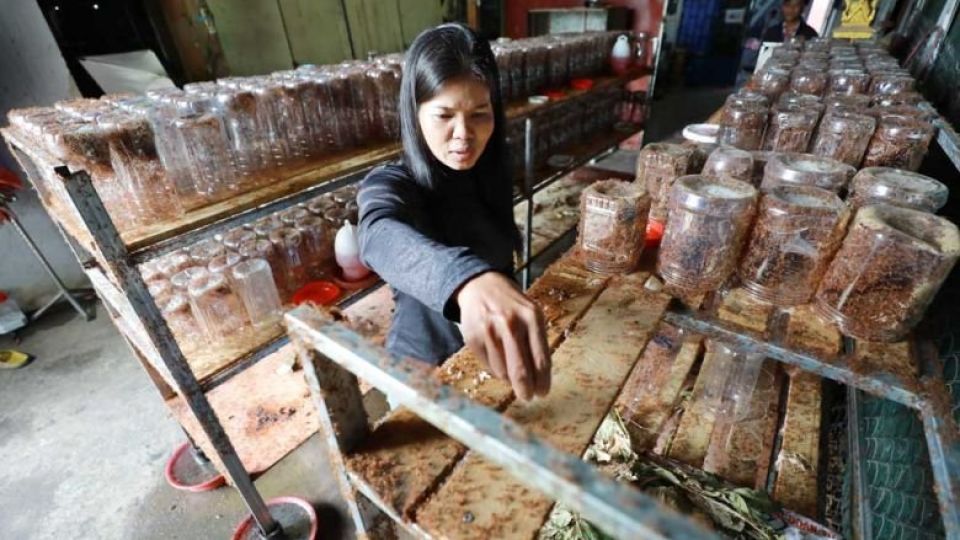January 12, 2023
PHNOM PENH – Forest dwelling weaver ants are a common species in the Kingdom, and often employed as a tasty addition to many traditional dishes like some sour soups, or prahok. They are usually collected wild from the countryside, but one enterprising woman has discovered how to raise them commercially.
Khem Sreymom has used a Covid-19 induced redundancy to pivot her career, and now successfully raises the ants at her home in Trapeang Krasaing village, Trapeang Krasaing commune, Por Sen Chey district, Phnom Penh.
She sat down with The Post to share the tale of how she developed her ground breaking skills.
Sreymom said she was born and raised in Sampov Poun commune of Kandal’s province’s Koh Thom district. She moved to Phnom Penh with her three sons, after her husband found work in the capital.
Originally, she found work at a garment factory in the same district as her home, but when the Covid-19 pandemic rolled through the region, the factory was shuttered.
After losing her job, she attempted to make a living selling traditional medicine, but the pandemic had reduced consumer spending to the point where demand was limited. As she watched her family’s financial well-being, she began to look for ideas for a new business.
She watched many videos that suggested raising fish, frogs or even snakes might be the answer to her income woes, and considered them as options. Sreymom rightly deduced that she would not be the only one watching the videos, and there was bound to be an oversupply in the near future.
Eventually, she stumbled on a video – in a foreign language – which described how to raise the ants for sale. Seeing a unique opportunity, she discussed the idea with her eldest son, who agreed to accompany her into the forest to find the first generation of her new project.
At first, they had a hard time, and were only able to relocate two nests back to their home. From these two nests, they were able to successfully breed ten separate colonies, each accommodated in a repurposed plastic bottle.
“As they grew, I watched them closely, identifying the different challenges they faced between living in the forest and living in my ant farms,” she said.
She said the populations grew so quickly that she hired a blacksmith to build steel racks to maximise storage of her individual farms.

Ant farms maintained by Khem Sreymom in Phnom Penh’s Por Sen Chey district. Hong Menea
At the same time, she began posting videos of her activities to Tik Tok, which led to many visitors, some of whom wanted to buy ant eggs from her.
This encouragement led to the growth of her operation, and her home now plays host to over 400 colonies of weaver ants.
She said the species usually thrives under very specific conditions. She has to ensure that the colonies are not exposed to direct sunlight or loud noises. In addition, strong winds prevent them from leaving their colony to forage.
“I have confirmed my findings by going online and reading about them. I have a good understanding off their habits and the environment I need to provide them with to make sure they are healthy,” she added.
She explained that weaver ants are a very clean species. For example, she sometimes feeds them raw chicken. They will take the meat into the nest for a few days, but once it spoils, worker ants will remove it and throw it away.
“They do the same thing when any of the ants die within the nest. The remains will be carried outside and disposed of,” she added.
She said that the ants appear to display surprising loyalty to their colony. If they are faced with an attack by an invasive species, the ants will sacrifice their lives to defend their home.
She generally feeds her ants a steady diet of dead crickets or chicken. When she can find them, she likes to feed them worms, as they are very high in protein.
In the forest, the ants drink nectar from flowers, but she is able to replicate this by making up sugar syrup for them. One and a half litres of sugary juice will feed up to 200 colonies for a day and a half.
The former garment worker said each type of ant has very specific riles in the reproductive cycle.
When an ant grows to adulthood, it may become a male or female, but they do not breed with each other. The male ants have black markings and wings, the queen is the only one in the nest that can lay eggs.
In addition to the above types, there are warrior ants, which are responsible for protecting the nest and finding food to supply the community. The others are nurses, and they have many roles, including moving eggs away from the sun and making sure they have enough oxygen.
Within each colony, the roles are very clearly defined. When a queen can no longer breed, she must leave the nest. If she refuses, the warrior ants will kill her.
She said she can harvest a new batch of ants every 15 or 20 days.
Hang Hoeung, director of the Phnom Penh Agricultural Extension Department of the Ministry of Agriculture, Forestry and Fisheries, told The Post that the department has a lot of experience raising animals such as chickens, pigs and cows, but very little expertise with Sreymom’s tiny livestock.
“I will contact the ministry’s Department of Agriculture to find out if this has been done in any other provinces, or if any NGO has any experience raising them,” he said.


